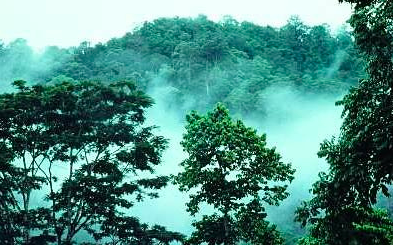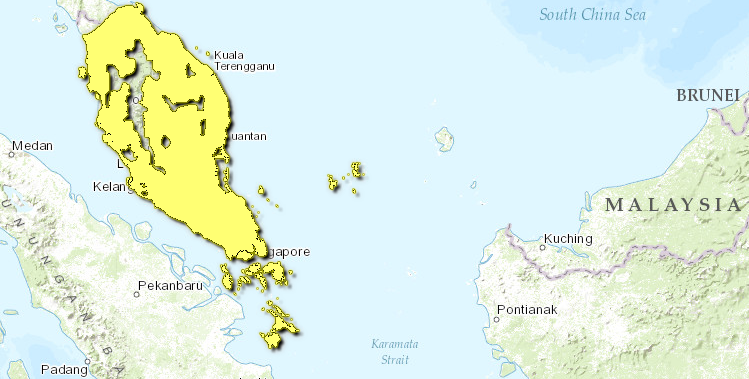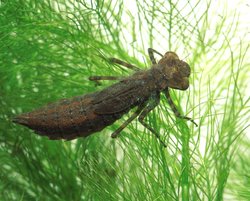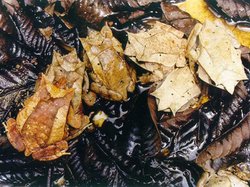Peninsular Malaysian lowland rainforests

Taman Negara National Park, Malaysia (Photograph by © WWF-Canon/Paul S. Sochaczewski)
The Peninsular Malaysian lowland rainforests ecoregion, with 195 mammal species, has the second most mammal species (Biodiversity) in the Indo-Pacific, behind the Borneo lowland rainforests. Yet most of the wide-ranging or top carnivore species lead a tenuous existence within these biologically noteworthy forests. The tiger, Asian elephant, Sumatran rhinoceros, Malayan tapir, gaur, and clouded leopard all fall into this category. As in many other tropical forests in this region, habitat loss and poaching are the two primary reasons for the decline in these and other species.
Location and General Description
This ecoregion is comprised of the lowland moist forests of Peninsular Malaysia and the extreme southern part of Thailand. There are no clear seasons in peninsular Malaysia, and rainfall is plentiful year-round. Two monsoons punctuate the region. From October to March a northeastern monsoon brings extra rain to the eastern side of Peninsular Malaysia. The southwest monsoon, which is more powerful, bathe the western side of peninsular Malaysia with rain from April to August. Based on the Köppen climate zone system, this ecoregion falls in the tropical wet climate zone.
These majestic forests are dominated by the Dipterocarpaceae tree family, notably Anisoptera spp., Dipterocarpus spp., Dryobalanops spp., Hopea spp., and Shorea spp. These forests contain a high diversity of tree species (an estimated 6000 species), and dominant species are uncommon. The general characteristics of these forests are canopies of 24 to 36 metres (m), with emergents reaching more than 45 m. Dipterocarpaceae is a dominant family in the emergent stratum. In the richest forests, up to 80 percent of the emergent trees are dipterocarps. Of the dipterocarps, Dipterocarpus, Dryobalanops, and Shorea are the emergents, and Hopea and Vatica usually are found in the main canopy. Berseraceae and Sapotaceae are other common main canopy families. The tallest tree species in these forests is not a dipterocarp but rather a legume. The Koompassia excelsa (known as tualang) can grow as tall as 76 m (250 feet). This tree is rarely felled when land is cleared because of its large size, hard wood, and huge buttresses. They are often laden with the wild honey-producing bees (Apis dorsata) and are therefore worth more money standing than being logged.
Riverine forests are bordered by neram trees (Dipterocarpus oblongifolius), figs (Ficus racemosa), and kelat (Eugenia grandis) and are draped with numerous epiphytic orchids and ferns. Below the canopy a layer of shade-tolerant species thrives. This layer includes many species (Biodiversity) from the Euphorbiaceae, Rubiaceae, Annonaceae, Lauraceae, and Myristicaceae families. Ground vegetation usually is sparse, mainly small trees, and herbs are uncommon.
This ecoregion also includes some karst limestone areas that are floristically rich. The limestone hills harbor more than 1200 species of vascular plants, of which at least 129 are endemic to this habitat, most limited to one or a few isolated hills.
Biodiversity Features
Peninsular Malaysia shares many of its tremendous species diversity with Sumatra and Borneo. All three landmasses were once part of a single, larger landmass during the recent Ice Age, when the sea level was more than 100 m lower than it is today. However, peninsular Malaysia retained a connection to Asian mainland, and the lowland forests have the greatest diversity of mammal species found in the Indo-Pacific region. Unfortunately for many of the wide-ranging or carnivorous species, survival in peninsular Malaysia is in doubt.
The tiger (Felis tigris) is peninsular Malaysia's largest predator. They exact estimate of the number of remaining tigers in peninsular Malaysia is not known, but estimates have ranged from 300 to 650 over the past decade. What is not in doubt is that Malaysia's tiger population is in danger of drifting toward extinction. As recent as the 1950s more than 3000 tigers were estimated to live in Malaysia. However, poaching, habitat loss, and inadequate protection have drastically reduced the population. Taman Negara Nature Reserve remains one of the last refuges for the tiger and several other endangered species. There are one Level I and two Level II Tiger Conservation Units (TCUs) in peninsular Malaysia that overlap this ecoregion.
The Malayan tapir (Tapirus indicus) is the largest of the four living tapir species and only Old World representative. The population of the Malayan tapir has been drastically reduced, but they survive in protected areas. Tapirs can be seen in the Ampang Forest Reserve, and the largest surviving population probably lives around Taman Negara National Park. Peninsular Malaysia is also home to the world's smallest rhinoceros, the two-horned Sumatran rhinoceros (Didermocerus sumatrensis). It once ranged through much of southeast Asia, but today the entire population numbers about 500 individuals scattered in isolated populations from peninsular Malaysia to Sumatra and Borneo. Populations of the rhinoceros survive at Sungai Dusun, Ulu Selama, and Endau-Rompin parks in peninsular Malaysia.
Peninsular Malaysia's largest land animal, the Asian elephant (Elephas maximus), is also one of the most endangered. They range over vast tracts of land throughout Peninsular Malaysia in search of food, and as habitat is destroyed the population has become fragmented and poached. The estimated population has varied widely from 600 to 6,000 elephants, demonstrating the poor knowledge of the actual status of this species (Biodiversity) in peninsular Malaysia. The second largest mammal in these forests is wild cattle, the gaur (Bos gaurus), or seladang as it is known in Malaysia. Widespread poaching and habitat loss (Habitat fragmentation) have drastically reduced gaur populations outside protected areas.
Numerous other mammal species live in these forests and include squirrels, deer, otter, civet, primates, the rare sun bear (Ursus malayanus), the clouded leopard (Pardofelis nebulosa), and many bat species.
Birds species richness is also high, with more than 450 species attributed to the ecoregion. These include several pheasants: the crestless fireback pheasant (Lophura erythrophthalma), crested fireback (Lophura ignita), Malay peacock pheasant (Polyplectron malacense), great argus pheasant (Argusianus argus), and crested argus pheasant (Rheinardia ocellata). Hornbills, barbets, bulbuls, woodpeckers, pigeons, broadbills, and babblers are other highly speciose or characteristic groups.
Current Status
Most of these lowland forests have been converted to rice fields, rubber and oil palm plantations, and orchards, with the northwestern region being the most intensively cultivated. Only about a fifth of the original forest cover now remains, scattered in fragments throughout the ecoregion. There are numerous protected areas that cover 3875 square kilometers (km2) (three percent) of this ecoregion (Table 1). With the exception of Taman Negara, all are less than 500 km2, many less than 10 km2. None of the alluvial swamp forest in the ecoregion is protected in peninsular Malaysia.
|
Table 1. WCMC (1997) Protected Areas That Overlap with the Ecoregion. | ||
|
Protected Area |
Area (km2) |
IUCN Category |
|
Unnamed |
210 |
? |
|
Unnamed |
160 |
? |
|
Pulau Redang |
20 |
PRO |
|
Taman Negara [IM0144] |
2,770 |
II |
|
Tasek Bera |
270 |
PRO |
|
Pulau Tioman |
130 |
VIII |
|
Mersing |
110 |
PRO |
|
Endau-Kota Tinggi (East) |
50 |
IV |
|
Sungei Buloh |
1 |
V |
|
Senko (Sungei Sembawang) |
1 |
REC |
|
Sungei Khatib Bongsu Heronry |
1 |
REC |
|
Kranji Heronry and Marshes |
2 |
REC |
|
Bukit Timah and Central catchment NR |
30 |
IV |
|
Nee Soon |
1 |
IV |
|
Bukit Timah extension |
1 |
IV |
|
Pasir Ris |
1 |
V |
|
Botanic Gardens |
1 |
UA |
|
Fort Canning |
1 |
UA |
|
Kent Ridge |
1 |
REC |
|
Labrador |
1 |
V |
|
Sentosa |
1 |
REC |
|
Pulau Bulan |
100 |
PRO |
|
Pulau Pasir Panjang |
2 |
PRO |
|
Pulau Penyengat |
10 |
PRO |
|
Total |
3,875 |
|
|
Ecoregion numbers of protected areas that overlap with additional ecoregions are listed in brackets. | ||
Types and Severity of Threats
Logging began in the 1950s, and by the 1970s, 3660 km2 of forests were being logged annually. But as the forest has been depleted of valuable timber trees, these rates have slowed. Logging is selective and therefore not a direct cause of forest loss but is often a preliminary to other forms of land use. The major cause of forest conversion in peninsular Malaysia is large-scale clearing for plantations and agriculture, especially of rubber, coconut, and oil palm for export production. Coffee and cocoa are minor crops. The threat of extensive plantations of pine trees for paper production has not materialized, but other quick-growing softwoods such as Acacia mangium are being favored. Hydropower and irrigation projects are a second major cause of forest loss, with mining and its associated road building and quarrying] around limestone areas such as Perak and Selangor being the third. The losses in terms of forest area are slight but tend to have high impact at specific sites. In comparison to these high-impact activities, the forest conversion and degradation from shifting cultivation by indigenous people is slight. Some of the last remnants of coastal dipterocarp forest in the state of Perak, peninsular Malaysia, are at high risk from the expansion of nearby urban areas. Because more than 80 percent of the mammal species of peninsular Malaysia live only in the lowland forests of this ecoregion and 53 percent are confined to primary forest, the degradation in this ecoregion severely reduces species diversity and long-term population viability in peninsular Malaysia as a whole.
Justification of Ecoregion Delineation
The Peninsular Malaysian Rain Forests ecoregion represents the large extent of the lowland broadleaf rain forests extending south of the Kangar-Pattani line to Singapore.
This ecoregion approximates the spatial extent of MacKinnon's subunit 07a, but we also included the Lingga and Riau archipelagos. Although FAO indicates that these islands contain heath forests, both Whitmore and MacKinnon dispute this classification, and MacKinnon identified the vegetation as lowland moist forest. The tropical montane evergreen moist forests above 1,000 meters (m) were placed in the Peninsular Malaysian Montane Rain Forests. We also extracted the large areas of peat swamp forests along the coast of peninsular Malaysia into the Peninsular Malaysian peat swamp forests. Thus, we created three ecoregions within MacKinnon's Malay Peninsular subunit (07a) and Udvardy's Malayan rainforests biogeographic province.
Additional information on this ecoregion
- For a terser summary of this entry, see the WWF WildWorld profile of this ecoregion.
See Also
| Disclaimer: This article contains information that was originally published by the World Wildlife Fund. Topic editors and authors for the Encyclopedia of Earth have edited its content and added new information. The use of information from the World Wildlife Fund should not be construed as support for or endorsement by that organization for any new information added by EoE personnel, or for any editing of the original content. |


